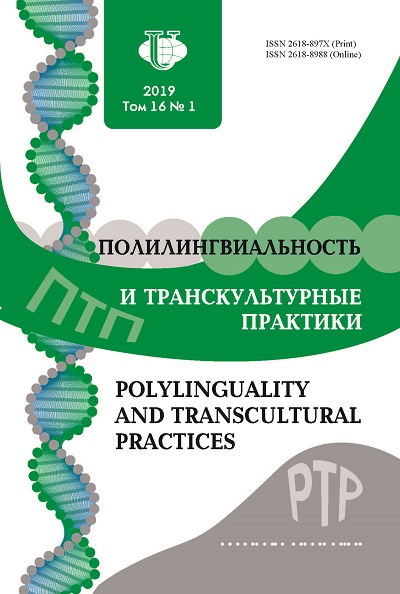Том 16, № 1 (2019)
- Год: 2019
- Статей: 16
- URL: https://journals.rudn.ru/polylinguality/issue/view/1172
- DOI: https://doi.org/10.22363/2618-897X-2019-16-1
Весь выпуск
К читателям
К ЧИТАТЕЛЯМ
 7-8
7-8


 9-12
9-12


Языковые контакты
Языковая социализация в двуязычных семьях: функциональное распределение языков в речи, обращенной к младенцам
Аннотация
 13-20
13-20


Языковые биографии представителей чувашской диаспоры Московского региона
Аннотация
В статье приводятся результаты социолингвистического обследования, проведенного автором в чувашской диаспоре Московского региона. Актуальное использование чувашского языка в условиях диаспорного проживания определяется в том числе и предшествующим языковым опытом респондентов на малой родине. Выделены периоды и наиболее общие черты языковой биографии (какие языки использовались респондентами в разговоре с родителями, старшими родственниками, сверстниками до школы, при поступлении в школу; на каком языке велось обучение в начальной школе, в средней школе, в техникуме или вузе; языки общения с соседями на малой родине) позволяют выявить различные пути усвоения респондентами этнического языка.
 21-34
21-34


Американский этап лингвистической биографии Питирима Сорокина
Аннотация
В статье рассматриваются особенности двуязычия выдающегося социолога ХХ века Питирима Сорокина в американский период его жизни в контексте жизненного пути и интеллектуальной биографии. Исследование выполнено по материалам научного архива Питирима Сорокина в Университете Саскачевана (Канада). Архивные рукописи и заметки позволяют проследить процесс смены языка и переключения кодов в профессиональной деятельности Питирима Сорокина после переезда в Соединенные Штаты Америки. Установлено, что использование Питиримом Сорокиным смешанного метаязыка при проработке и осмыслении иноязычных научных трудов может рассматриваться как дополнительное свидетельство сохранения связи с русским периодом своей жизни и научной деятельности. Русский язык оставался и использовался как рабочий инструмент научного мышления, планирования и управления научной деятельностью.
 35-44
35-44


Художественное измерение
Транслингвизм, транскультуральность и этнокультурная идентичность: комплементарность или конфликтность?
Аннотация
 45-51
45-51


Феномен Ч.Т. Айтматова: к 90-летию со дня рождения писателя
Аннотация
Исследуется феномен художественного мира писателя, уникальность которого обусловлена особой авторской оптикой, проявляющейся в мифопоэтическом и философском постижении жизни, в «новом» мышлении, в создании целостного национального образа мира, в «языковом космосе» писателя-билингва. На материале текстов произведений «Белый пароход», «И дольше века длится день», «Плаха», «Когда падают горы (Вечная невеста)» и др. анализируются поэтика заглавия, пространственные локусы и образы животных, функция мотивов, семантика круга, специфика поэтического языка. Жажда творчества как потребность «художественного восприятия жизни» рассматривается в статье в двух основных аспектах, сформулированных самим Айтматовым как ответственность художника слова перед будущим: «познание бесконечной красоты и бесконечной противоречивости мира». Результаты анализа текстов соотносятся в статье с творческими принципами автора, что позволило определить феномен художественного мира писателя-билингва как выход на «новый уровень сознания» (Ч.Т. Айтматов «Языковой космос»).
 52-62
52-62


Пути самоидентификации лирического субъекта Р. Бухараева (на материале цикла «Венок дикорастущих сонетов»)
Аннотация
 63-72
63-72


Транскультурация героя в романе Г. Бельгера «Дом скитальца»
Аннотация
С помощью приемов литературоведческого анализа автор пытается проследить эволюцию героя романа Г. Бельгера в аспекте транскультурного подхода. Центральным объектом исследования послужил архетип «дом». Автор приходит к выводу, что связанные с указанным архетипом элементы разного уровня - от онтологических категорий («тут-бытие», «там-бытие») до символов позволяют эксплицировать идею Бельгера о вседомности, которая служит альтернативой внедомности и вненаходимости.
 73-83
73-83


Теория перевода
Частица - маленькая лексическая единица или бесконечный научный проект?
Аннотация
 84-94
84-94


Билингвальное образование
Особенности преподавания русского языка как иностранного в билингвальной аудитории
Аннотация
Статья посвящена особенностям преподавания русского языка студентам-билингвам (преодоление низкой мотивации глубокого изучения языка, трудности в письменной речи, социализация в межкультурном общении, проблемы при изучении языка специальности). Авторы отмечают, что в специальную Программу, созданную для обучения билингвов, вошли разделы, содержащие работу по расширению лексического состава языка, работу с текстами, образцами письменной речи, аудиои видеоматериалами. Большую роль в изучении русского языка играет овладение языком специальностии внеаудиторная работа.
 95-101
95-101


Потенциал поликодовых сообщений в организации оперативного взаимодействия «средство обучения - пользователь»
Аннотация
Статья посвящена проблеме оптимизации оперативного взаимодействия средства обучения и пользователя. В статье обоснована необходимость создания поликодового интерфейса управления взаимодействием, определены цели его создания, а также сформулированы основные принципы его разработки. Главным формообразующим критерием создания интерфейса является его эргономичность. Поликодовый интерфейс особенно эффективен при обучении в многоязычной поликультурной среде, когда передача информации символом или иконическим элементом эффективно снимает трудности понимания операционной информации. В статье анализируются общепринятые стандарты взаимодействия «учебник - пользователь» по пяти основным направлениям. На основе анализа выявлены два направления, в которых поликодовые сообщения не применяются, хотя обладают значительным дидактическим потенциалом. Статья представляет авторскую разработку поликодового интерфейса оперативного взаимодействия и ее практическую реализацию в комплексе средств обучения по русскому языку для начального этапа.
 102-111
102-111


Круглый стол
 112-124
112-124


Memento
 125-131
125-131


Релиз
«Внутри мыслящих миров»: рецензия на сборник материалов Международной научно-практической конференции «Би-, поли-, транслингвизм и языковое образование». Москва: РУДН, 2018. 448 с
Аннотация
 132-135
132-135


Региональный методический семинар «Зимние чтения - 2019»
 136-138
136-138














